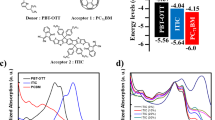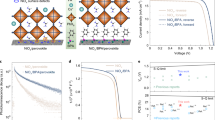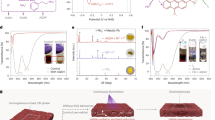Abstract
Inorganic–organic hybrid structures have become innovative alternatives for next-generation dye-sensitized solar cells, because they combine the advantages of both systems. Here, we introduce a layered sandwich-type architecture, the core of which comprises a bicontinuous three-dimensional nanocomposite of mesoporous (mp)-TiO2, with CH3NH3PbI3 perovskite as light harvester, as well as a polymeric hole conductor. This platform creates new opportunities for the development of low-cost, solution-processed, high-efficiency solar cells. The use of a polymeric hole conductor, especially poly-triarylamine, substantially improves the open-circuit voltage Voc and fill factor of the cells. Solar cells based on these inorganic–organic hybrids exhibit a short-circuit current density Jsc of 16.5 mA cm−2, Voc of 0.997 V and fill factor of 0.727, yielding a power conversion efficiency of 12.0% under standard AM 1.5 conditions.
This is a preview of subscription content, access via your institution
Access options
Subscribe to this journal
Receive 12 print issues and online access
$209.00 per year
only $17.42 per issue
Buy this article
- Purchase on Springer Link
- Instant access to full article PDF
Prices may be subject to local taxes which are calculated during checkout



Similar content being viewed by others
References
Green, M. A., Emery, K., Hishikawa, Y., Warta, W. & Dunlop, E. D. Solar cell efficiency tables (version 39). Prog. Photovolt. Res. Appl. 20, 12–20 (2012).
O'Regan, B. & Grätzel, M. A low-cost, high-efficiency solar cell based on dye-sensitized colloid TiO2 films. Nature 353, 737–740 (1991).
Yella, A. et al. Porphyrin-sensitized solar cells with cobalt (II/III)-based redox electrolyte exceed 12 percent efficiency. Science 334, 629–634 (2011).
Chung, I. et al. All-solid-state dye-sensitized solar cells with high efficiency. Nature 485, 486–489 (2012).
Zhang, W. et al. High-performance solid-state organic dye sensitized solar cells with P3HT as hole transporter. J. Phys. Chem. C 115, 7038–7043 (2011).
Burschka, J. et al. Tris(2-(1H-pyrazol-1-yl)pyridine)cobalt(III) as p-type dopant for organic semiconductors and its application in highly efficient solid-state dye-sensitized solar cells. J. Am. Chem. Soc. 133, 18042–18045 (2011).
Mora-Sero, I. & Bisquert, J. Breakthroughs in the development of semiconductor-sensitized solar cells. J. Phys. Chem. Lett. 1, 3046–3052 (2010).
Sun, J. & Goldys, E. M. Linear absorption and molar extinction coefficients in direct semiconductor quantum dots. J. Phys. Chem. C 112, 9261–9266 (2008).
Hanewinkel, B., Knorr, A., Thomas, P. & Koch, S. W. Optical near-field response of semiconductor quantum dots. Phys. Rev. B 55, 13715–13725 (1997).
Chang, J. A. et al. High-performance nanostructured inorganic–organic heterojunction solar cells. Nano Lett. 10, 2609–2612 (2010).
Im, S. H. et al. All solid state multiply layered PbS colloidal quantum-dot-sensitized photovoltaic cells. Energy Environ. Sci. 4, 4181–4186 (2011).
Im, S. H. et al. Toward interaction of sensitizer and functional moieties in hole-transporting materials for efficient semiconductor-sensitized solar cells. Nano Lett. 11, 4789–4793 (2011).
Chang, J. A. et al. Panchromatic photon-harvesting by hole-conducting materials in inorganic–organic heterojunction sensitized-solar cell through the formation of nanostructured electron channels. Nano Lett. 12, 1863–1867 (2012).
Boix, P. P. et al. From flat to nanostructured photovoltaics: balance between thickness of the absorber and charge screening in sensitized solar cells. ACS Nano 6, 873–880 (2012).
Kojima, A., Teshima, K., Shirai, Y. & Miyasaka, T. Organometal halide perovskites as visible-light sensitizers for photovoltaic cells. J. Am. Chem. Soc. 131, 6050–6051 (2009).
Im, J.-H. et al. 6.5% efficient perovskite quantum-dot-sensitized solar cell. Nanoscale 3, 4088–4093 (2011).
Kim, H.-S. et al. Lead iodide perovskite sensitized all-solid-state submicron thin film mesoscopic solar cell with efficiency exceeding 9%. Sci. Rep. 2, 591 (2012).
Lee, M. M. et al. Efficient hybrid solar cells based on meso-superstructured organometal halide perovskites, Science 338, 643–647 (2012).
Ziyong Cheng, Z. & Lin, J. Layered organic–inorganic hybrid perovskites: structure, optical properties, film preparation, patterning and templating engineering. CrystEngComm 12, 2646–2662 (2010).
Etgar, L. et al. Mesoscopic CH3NH3PbI3/TiO2 heterojunction solar cells, J. Am. Chem. Soc. 134, 17396–17399 (2012).
Nanu, M., Schoonman, J. & Goossens, A. Nanocomposite three-dimensional solar cells obtained by chemical spray deposition. Nano Lett. 5, 1716–1719 (2005).
Zhang, W. et al. Systematic improvement in charge carrier mobility of air stable triarylamine copolymers. J. Am. Chem. Soc. 131, 10814–10815 (2009).
Ebadian, S. et al. Effects of annealing and degradation on regioregular polythiophene-based bulk heterojunction organic photovoltaic devices. Sol. Energy Mater. Sol. Cells 94, 2258–2264 (2010).
Namkoong, G., Boland, P., Lee, K. & Dean, J. Design of organic tandem solar cells using PCPDTBT:PC61BM and P3HT:PC71BM. J. Appl. Phys. 107, 124515 (2010).
Kim, B. et al. A selenophene analogue of PCDTBT: selective fine-tuning of LUMO to lower the bandgap for efficient polymer solar cells. Macromolecules 45, 8658–8664 (2012).
Shen, L. et al. Performance improvement of TiO2/P3HT solar cells using CuPc as a sensitizer. Appl. Phys. Lett. 92, 073307 (2008).
Morana, M. et al. Bipolar charge transport in PCPDTBT-PCBM bulk-heterojunctions for photovoltaic applications. Adv. Funct. Mater. 18, 1757–1766 (2008).
Acknowledgements
This work was supported by the Global Research Laboratory (GRL) Program, the Global Frontier R&D Program at the Center for Multiscale Energy System funded by the National Research Foundation in Korea, and by a grant from the KRICT 2020 Program for Future Technology of the Korea Research Institute of Chemical Technology (KRICT), Republic of Korea. M.G. expresses his gratitude to the European Research Council (ERC) for supporting part of this work under an advanced research grant (no. 247404, MESOLIGHT).
Author information
Authors and Affiliations
Contributions
S.I.S. and S.H.I. conceived the experiments, carried out data analysis and prepared the manuscript. M.G. and M.K.N. contributed to the analysis of data and revision of the manuscript. J.H.H., J.H.N. and S.H.I carried out preparation of the devices and device performance measurements. T.N.M. and C.-S.L. synthesized materials for CH3NH3PbI3 and S.I.S prepared TiO2 pastes for the electrodes. Y.H.L., H.J.K. and A.S. prepared the mesoporous electrode. J.A.C. fabricated test specimens for comparisons. S.I.S. and M.G directed the study. All authors discussed the results and commented on the manuscript.
Corresponding authors
Ethics declarations
Competing interests
The authors declare no competing financial interests.
Supplementary information
Supplementary information
Supplementary information (PDF 1488 kb)
Rights and permissions
About this article
Cite this article
Heo, J., Im, S., Noh, J. et al. Efficient inorganic–organic hybrid heterojunction solar cells containing perovskite compound and polymeric hole conductors. Nature Photon 7, 486–491 (2013). https://doi.org/10.1038/nphoton.2013.80
Received:
Accepted:
Published:
Issue Date:
DOI: https://doi.org/10.1038/nphoton.2013.80
This article is cited by
-
Thermal engineering control of inorganic perovskite CsPbIBr2 film and optimization of photoelectric performance
Journal of Nanoparticle Research (2024)
-
Optimizing lead-free Cs3Bi2I9 perovskite solar cells: exploring absorber and charge transport layers parameters for improved efficiency
Journal of Optics (2024)
-
Dissolved-Cl2 triggered redox reaction enables high-performance perovskite solar cells
Nature Communications (2023)
-
Self-healing perovskite solar cells based on copolymer-templated TiO2 electron transport layer
Scientific Reports (2023)
-
Tailoring passivators for highly efficient and stable perovskite solar cells
Nature Reviews Chemistry (2023)



